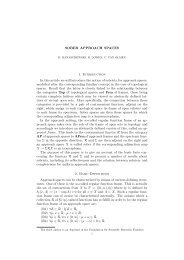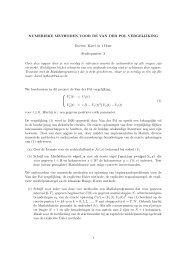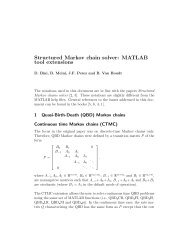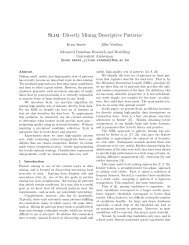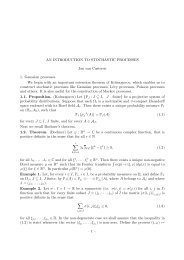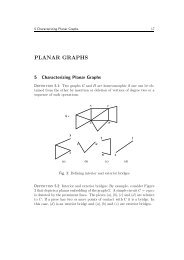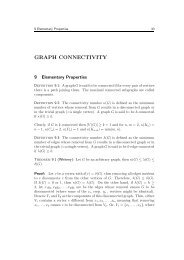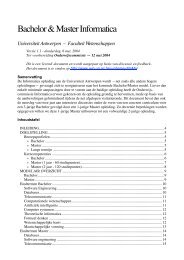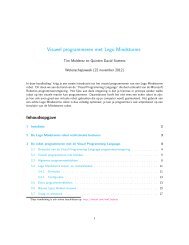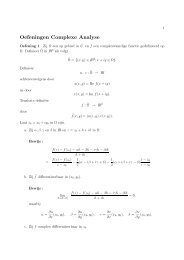Levelwise Cluster Mining under a Maximum SSE Constraint
Levelwise Cluster Mining under a Maximum SSE Constraint
Levelwise Cluster Mining under a Maximum SSE Constraint
Create successful ePaper yourself
Turn your PDF publications into a flip-book with our unique Google optimized e-Paper software.
<strong>Levelwise</strong> <strong>Cluster</strong> <strong>Mining</strong> <strong>under</strong> a <strong>Maximum</strong><br />
<strong>SSE</strong> <strong>Constraint</strong><br />
Jeroen De Knijf, Bart Goethals, and Adriana Prado<br />
University of Antwerp, Belgium<br />
Abstract. In this work we cast the problem of finding clusters in the<br />
dataset into a frequent itemset mining problem. We show that the <strong>SSE</strong><br />
measures is monotone with respect to set inclusion, and use this property<br />
in an Apriori style algorithm to find optimal clusters in the data. Some<br />
preliminary experiments are reported on real life data.<br />
1 Introduction<br />
<strong>Cluster</strong>ing is identified as one the core problems in data mining [1]. Moreover,<br />
clustering plays a prominent role in many different disciplines in science and<br />
engineering, including bio-informatics, linguistics, pattern recognition, earth science<br />
and so on. The past decades a waste number of clustering algorithms have<br />
been proposed, for example [2–6]. These algorithms mainly differ in required<br />
level of domain knowledge, type of cluster that can be found and suitability for<br />
high dimensional data. In general, a clustering algorithm uses a similarity measure<br />
between objects in order to find an optimal grouping. That is, each group<br />
consists of objects that are similar to themselves and dissimilar to objects in<br />
other groups. The definition of similarity varies between the different clustering<br />
algorithms and depends upon the application domain. Principally, all possible<br />
groupings of the data points needs to be considered, which result in an exponential<br />
search space. Because of the exponential search space an exact, optimal<br />
solution is often infeasible to compute, even for dataset of small size. Therefore,<br />
clustering algorithms make use of heuristics to approximate an optimal solution<br />
<strong>under</strong> the similarity measure used. One of the most popular clustering methods<br />
for points in Euclidean space is called k-means clustering. Given a set P of n<br />
data points in d-dimensional space R d , and an integer k, the problem is to<br />
determine a set of k points in R d , usually referred to as centers, that minimizes<br />
the mean squared Euclidean distance from each data point to it nearest center.<br />
This measure is often referred to as Sum of Squared Error, or distortion.<br />
The problem of finding groups of data <strong>under</strong> given constraints, is a well<br />
studied problem in the area of frequent pattern mining. For example, in frequent<br />
itemset mining [7] the goal is to derive all sets that occur more often than a<br />
user-specified threshold. To accomplish this, a level wise algorithm is used that<br />
employs the monotonicity of the constraint to limit the search space. Recent<br />
involvements in frequent itemset mining is to derive the most ’interesting’ sets<br />
that best represent the input data [8–14].
In this paper we use the constraints to find an optimal clustering in an<br />
Apriori-style algorithm. We show that the <strong>SSE</strong> constraint is monotone <strong>under</strong><br />
set inclusion, and use this fact in our mining algorithm, to perform a level wise<br />
search towards the optimal solution. The resulting sets represents groups of<br />
points that are more close towards each other than to any other points in the<br />
input data. Finally, the post-processing step takes as input all derived sets and<br />
combine the ones that best partition the data. Contrary to k-means, we do not<br />
use a parameter that specify the number of desired clusters in the data. Instead,<br />
our algorithm produces several clusterings, where the kth iteration produces in<br />
general far less clusters than the k − 1 iteration. As a result, a user is not faced<br />
with cumbersome process of apriori determining the exact clusters and hence<br />
our algorithm can be used for truly explorative data analysis tasks.<br />
The rest of this paper is organized as follows: in the next section we introduce<br />
the basic concepts and the notation used. In section 3 we present the mining<br />
algorithm <strong>Maximum</strong> <strong>SSE</strong> Miner (M<strong>SSE</strong>M). The following section describes the<br />
experiments performed on several real life datasets. Finally, in the last section we<br />
discuss the results, draw conclusions and give some pointers for further research.<br />
2 Preliminaries<br />
Given x, y, with x, y ∈ R d , let ∆(x, y) denote the Euclidean distance between x<br />
and y, i.e.<br />
∑<br />
∆(x, y) = √ d (x i − y i ) 2 .<br />
Moreover, let ∆ 2 (x, y) denotes the squared distance between x and y, i.e.<br />
i<br />
∆ 2 (x, y) =<br />
d∑<br />
(x i − y i ) 2 .<br />
i<br />
For a finite set X ⊂ R d and a point y ∈ R d the <strong>SSE</strong> of X relatively to y, denoted<br />
as <strong>SSE</strong>(X, y), equals the sum of the squared distances between any point in X<br />
and y, i.e.<br />
<strong>SSE</strong>(X, y) = ∑ x∈X<br />
∆ 2 (x, y).<br />
In this paper, we only use the <strong>SSE</strong> of X relatively to the mean of X, which we<br />
abbreviate to <strong>SSE</strong>(X).<br />
2.1 Problem Statement<br />
Given a finite set P ⊂ R d of size n, the goal is to derive k sets {P 1 , . . . , P k } such<br />
that the k sets are a partition of P with minimal <strong>SSE</strong>, more formally:<br />
1. P i ∩ P j = ∅ for 1 ≤ i, j ≤ k and i ≠ j.
2. ⋃ k<br />
i=1 P i = P.<br />
3. ̸ ∃{M 1 , . . . , M k } such that:<br />
(a) M i ∩ M j = ∅ for 1 ≤ i, j ≤ k and i ≠ j.<br />
(b) ⋃ k<br />
i=1 M i = P.<br />
(c) ∑ k<br />
i=1 <strong>SSE</strong>(M i) < ∑ k<br />
i=1 <strong>SSE</strong>(P i).<br />
As stated earlier, in this work we don’t apriori fix the k value. Instead we<br />
derive a whole range of k values and the corresponding clusterings. Further<br />
noteworthy, the trivial solution for the problem stated above is to take the k<br />
value equal to the number of points in the input data, i.e. k = |P |. However,<br />
this valid solution is from a user perspective worthless.<br />
3 Algorithm<br />
In this section we describe the different components of M<strong>SSE</strong>M in more<br />
detail. But first we show that the <strong>SSE</strong> measure is monotone <strong>under</strong> set inclusion.<br />
It is well known from literature (see for example [2]) that the best point to<br />
minimize the <strong>SSE</strong> of a set X is the mean or center of X. Given this observation,<br />
we can state our theorem on which this algorithm is base.<br />
Theorem 1 (Monotonicity of the <strong>SSE</strong> measure w.r.t. set inclusion)<br />
For any two finite set X, Y ∈ R d it holds that:<br />
X ⊆ Y ⇒ <strong>SSE</strong>(X) ≤ <strong>SSE</strong>(Y ).<br />
Proof. Let Z contain the points of Y which are not part of X, i.e. Z = Y \ X.<br />
Moreover, let c 1 be the center of X and c 2 be the center of Y . Because, the<br />
center of a set is the points that minimizes the <strong>SSE</strong> of the set we have that<br />
<strong>SSE</strong>(X, c 2 ) ≥ <strong>SSE</strong>(X, c 1 ). Moreover, because <strong>SSE</strong>(Z, c 2 ) ≥ 0 it follows that<br />
<strong>SSE</strong>(X, c 2 ) + <strong>SSE</strong>(Z, c 2 ) ≥ <strong>SSE</strong>(X). Hence, <strong>SSE</strong>(X) ≤ <strong>SSE</strong>(Y ).<br />
Given the previous theorem, a straightforward approach would be to derive<br />
all maximal sets for a user defined maximum <strong>SSE</strong> threshold. Next, a postprocessing<br />
step is applied to extract a cover of the data. However, such a simple<br />
approach result in multiple problems. First, for realistic dataset it is unlikely<br />
that in the ideal clustering, all clusters have more or less the same <strong>SSE</strong> value.<br />
This, because some regions are more dense than other and the number of points<br />
in the true clusters can vary drastically. Hence, the maximum <strong>SSE</strong> value needed<br />
to find interesting clusters in one region of the input space, results in an explosion<br />
of patterns in another region. The other way around, the maximum <strong>SSE</strong><br />
value needed in a dense region would overlook possible clusters in sparse regions.<br />
Second, determining a reasonable value for the maximum <strong>SSE</strong> is an almost impossible<br />
task for a user.<br />
To overcome these problems we applied a mining algorithm for every point<br />
in the data and its region. A region of a point is defined as the points that
are not further away than the average distance between all point in the data.<br />
Moreover, the support threshold for a region depends on the density of the<br />
region. Finally, we define an order among the points depending on the number<br />
of points in its region. Points in more dense regions are processed before points in<br />
sparser regions, moreover the points in dense regions are removed from all other<br />
regions after they have been processed. As a result, for every point p ∈ P and<br />
its region denoted as p r the mining algorithm enumerate sets {i, . . . , j} where<br />
{i, . . . , j} ⊆ p r and ∀x ∈ {i, . . . , j} : ord(x) > ord(p). Where ord(p) denotes the<br />
order assigned to p which depends on |p r |.<br />
Algorithm 1 Derive all sets that satisfy the constraints<br />
Input: P, npoints<br />
Output: all set that satisfy the constraint<br />
1: OUT ← ∅<br />
2: mean ∆(P ) ← mean distance between all pair of point in P<br />
3: for all p ∈ P do<br />
4: p r ← p r ∪ {q|q ∈ P ∧ ∆(p, q) ≤ mean ∆(P )}<br />
5: end for<br />
6: sort(P ) according to |p r| in descending order<br />
7: ∀p ∈ P , ord(p) equals the position of p in array<br />
8: remove of all occurrences of point p in q r if ord(p) < ord(q)<br />
9: for all p ∈ P do<br />
10: OUT ← OUT ∪ mine({p}, pr,mean ∆(P )×mean ∆ (P )×npoints<br />
|p r|<br />
)<br />
11: end for<br />
12: return OUT<br />
The next question to answer is, what is a good maximum <strong>SSE</strong> threshold for<br />
a region p r and perhaps even more important how does the threshold for p r<br />
relates to a threshold for q r , with q ∈ P . Let mean ∆ (P ) denote the average<br />
distance between all pair of points in P . Obviously, if we take mean ∆ (P ) ×<br />
mean ∆ (P ) × |p r | as maximum <strong>SSE</strong> then {p} ∪ p r is the maximal set that satisfy<br />
the <strong>SSE</strong> constraint. Clearly, taking this value as maximum <strong>SSE</strong> is senseless.<br />
Instead, we let a user specify how many points should approximately be in<br />
the largest set. Given this parameter, we derive the maximum <strong>SSE</strong> as follows:<br />
mean ∆ (P )×mean ∆ (P )×# of points<br />
|p r|<br />
. Note that, we use the same input parameter<br />
(# of points) for all different regions. The pseudo-code of these pre-processing<br />
steps is given in Algorithm 1. The input arguments are the set of points P and<br />
the used defined parameter npoints. The lines 2 − −8 are used to compute the<br />
region for each point in the dataset. On line 10, the levelwise mining algorithm is<br />
called (Algorithm 2), for each point in the dataset and its previously computed<br />
region.<br />
The pseudo-code of the actual mining algorithm, is given in Algorithm 2. As<br />
stated earlier, this algorithm is a straightforward levelwise algorithm that uses<br />
Theorem 1 to limit the search space. Again, we assume an ordering on the points
Algorithm 2 level wise search algorithm<br />
Input: {p 1, . . . , p n}, p r, maxsse<br />
Output: all subsets of p r with a lower <strong>SSE</strong> than maxsse<br />
1: mean ∆(P ) ← mean distance between all pairs of points in P<br />
2: for all q ∈ p r do<br />
3: if max({ord(p 1), . . . , ord(p n)}) < ord(q) ∧ <strong>SSE</strong>({p 1, . . . , p n} ∪ {q}) ≤ maxsse<br />
then<br />
4: OUT ← OUT ∪ {{p 1, . . . , p n} ∪ {q}}<br />
5: OUT ← OUT ∪ mine({p 1, . . . , p n} ∪ {q}, p r, maxsse)<br />
6: end if<br />
7: end for<br />
8: return OUT<br />
in the region. However, this order can be the same as determined in Algorithm 1.<br />
In general, the output of the levelwise search algorithm consists of overlapping<br />
sets that satisfy the constraint. Hence, the output is not an partition of the input<br />
space.<br />
Algorithm 3 Post-processing the results<br />
Input: A List L of all sets that satisfy the max <strong>SSE</strong> constraint<br />
Output: RES a clustering of the input<br />
1: while L ≠ ∅ do<br />
2: sort L first according to cluster size, then according to <strong>SSE</strong><br />
3: RES ← RES ∪ top(L)<br />
4: for all X ∈ L do<br />
5: if X ∩ top(L) ≠ ∅ then<br />
6: L ← L \ X<br />
7: end if<br />
8: end for<br />
9: end while<br />
10: return RES<br />
To select a partition from all the sets that best describe the input data we<br />
use a simple heuristic to take the cover of the input data. The pseudo-code of<br />
this post-processing step is given in Algorithm 3. First we order the output sets<br />
on the number of points they contain (line 2). In case two sets have equal size<br />
they are ordered on <strong>SSE</strong> value. Then the first set in the ordered list is taken and<br />
added to the results (line 3). Next, all sets that contain one or more points of the<br />
set that is previously added to the results are removed (line 4 − −8). We repeat<br />
this procedure till all output sets are either removed or in the results sets.<br />
Finally, to deliver a whole range of number of clusters we repeat the algorithms<br />
on the output derived. More precisely, let {X 1 , . . . , X k } be the k clusters<br />
derived on input P . Then, for each X i with 1 ≤ i ≤ k we take the center of
Algorithm 4 Max <strong>SSE</strong> Miner<br />
Input: P, npoints<br />
1: RES ← ∅<br />
2: while |RES| ̸= |P | do<br />
3: L ← Pre-process(P, npoints)<br />
4: RES ← Post-process(L)<br />
5: DISPLAY(RES)<br />
6: P ← ∅<br />
7: for all X ∈ RES do<br />
8: P ← P ∪ mean(X)<br />
9: end for<br />
10: end while<br />
X i and add these points to a new input set P ′ . We repeat the previously described<br />
algorithms on the newly created input set. This repetition stops when<br />
the number of clusters obtained stays the same. The pseudo-code of the M<strong>SSE</strong>M<br />
algorithm is given in Algorithm 4. The input parameters of this algorithm is the<br />
set of points P and the user specified parameter npoints, the output is range of<br />
clusterings of the input set.<br />
We implemented a prototype of the described M<strong>SSE</strong>M algorithm. However,<br />
for practical reasons more optimizations could be applied. One obvious optimization<br />
is to derive only maximal sets that satisfy the user defined threshold. Note<br />
that in this case it is, because of the post-processing step used, highly likely that<br />
we need to recompute the support of one or more of the subsets of a maximal<br />
set. Further, note that concepts as closed sets are not interesting because of the<br />
continuous scale of the support.<br />
4 Experiments<br />
In this section, we report on the preliminary results obtained of the M<strong>SSE</strong>M<br />
mining algorithm on three real life datasets. The goal of the experiments is<br />
to qualitatively compare our results, with the results obtained by k-means as<br />
implemented in Weka [15]. For the evaluation of the clusters, we use the sum<br />
of the <strong>SSE</strong> values for the different clusters. To compare the results to k-means,<br />
we performed for each obtained clustering of M<strong>SSE</strong>M a run of k-means with as<br />
input parameter exactly the same number of clusters as the number of clusters<br />
that obtained by M<strong>SSE</strong>M. Another criterion mentioned is, if M<strong>SSE</strong>M is able to<br />
derive the true number of clusters, where the true number of clusters means the<br />
actual classes in the dataset.<br />
We used three real-word datasets, all available in the UCI repository [16].<br />
The characteristics of the datasets are presented in Table 4. We only consider<br />
the descriptive dimensions for clustering, while the class attribute is used in<br />
order to evaluate the result.
8<br />
120<br />
7<br />
100<br />
6<br />
5<br />
80<br />
<strong>SSE</strong><br />
4<br />
<strong>SSE</strong><br />
60<br />
3<br />
40<br />
2<br />
1<br />
20<br />
0<br />
0 10 20 30 40 50 60 70 80 90<br />
# of clusters<br />
0<br />
0 20 40 60 80 100 120 140 160 180 200<br />
# of clusters<br />
Fig. 1. Results for the Iris dataset (left) and the Ecoli dataset (right). The dashed line<br />
with square markers states the results obtained by the M<strong>SSE</strong>M approach. The dotted<br />
line with circle markers denote the results obtained by the k-means algorithm.<br />
Dataset #points #dimensions #classes<br />
Iris 150 5 3<br />
Ecoli 336 8 8<br />
Sonar 208 61 2<br />
Table 1. Characteristics of the dataset used.<br />
The results obtained for the Iris dataset and the Ecoli dataset are displayed<br />
in Figure 1. For both datasets M<strong>SSE</strong>M obtained the true number of clusters.<br />
The results shows that for almost all clusterings obtained by M<strong>SSE</strong>M the corresponding<br />
<strong>SSE</strong> value is better than the <strong>SSE</strong> value obtained by k-means. For<br />
the Ecoli dataset the difference is considerable. For different support values the<br />
results were more or less the same, except that M<strong>SSE</strong>M did not always succeed<br />
in finding the true number of clusters. The results for the Sonar dataset (displayed<br />
in Figure 2) show a somewhat different pictures. The results obtained for<br />
M<strong>SSE</strong>M are, in all but one case, slightly worse than those obtained by k-means.<br />
Moreover, M<strong>SSE</strong>M was not able to find the true number of clusters.<br />
5 Related Work<br />
Although a lot of clustering algorithms have been proposed, for example [2–6],<br />
almost no approaches uses local patterns. In this section we briefly review some<br />
clustering approaches that does uses local patterns.<br />
For market basket data, Wang et al. [17] uses the frequency of itemsets to<br />
form clusters. With this approach they avoid pairwise comparison between the<br />
different items. Recently, Van Leeuwen et al. [18] uses an MDL based approach<br />
to partition transactional data. First, a so called code table is constructed from
450<br />
400<br />
350<br />
300<br />
<strong>SSE</strong><br />
250<br />
200<br />
150<br />
100<br />
50<br />
0 10 20 30 40 50 60 70 80 90 100<br />
# of clusters<br />
Fig. 2. Results for the Sonar dataset. The dashed line with square markers states the<br />
results obtained by the M<strong>SSE</strong>M approach. The dotted line with circle markers denote<br />
the results obtained by the k-means algorithm.<br />
local patterns, then they search for an optimal decomposition of the code tables<br />
that partition the data. One major difference between M<strong>SSE</strong>M and the two<br />
previously described approaches is that M<strong>SSE</strong>M operates on numerical data<br />
while the other approaches require transactional data.<br />
In subspace clustering, the goal is to find clusters in one or more axis-parallel<br />
subspaces of the input space. CLIQUE [5] is a grid based subspace mining algorithm.<br />
For all dimensions, the data space is partitioned by a grid of equisized<br />
bins. All bins that contains more than a user defined threshold number of point<br />
are considered dense. A cluster is defined as a maximal set of adjacent dense<br />
bins. Starting with all one-dimensional dense units, the algorithms uses a level<br />
wise search to enumerate (k + 1) dimensional dense unit. In general the number<br />
of clusters found by CLIQUE can be enormous. The difference with our approach<br />
is that CLIQUE find clusters in all different axis-parallel subspaces and that the<br />
similarity measure is density instead of <strong>SSE</strong>.<br />
6 Discussion and Conclusion<br />
In this paper, we showed that the <strong>SSE</strong> measure is monotone with respect to<br />
set inclusion and proposed an algorithm that uses the <strong>SSE</strong> measure as monotone<br />
constraint in an Apriori style algorithm. We implemented a prototype of<br />
M<strong>SSE</strong>M and conducted some preliminary experiments on real datasets. Besides<br />
implementation issues, there are some more points of consideration:<br />
1. While M<strong>SSE</strong>M reports a whole range of possible clusterings, it is not guaranteed<br />
that the true number of clusters will be derived. Moreover, the number<br />
of clusters derived is rather sensitive for the user defined input parameter.
One possible direction to solve these problems is to perform more advanced<br />
post-processing, i.e. instead of our simple heuristic algorithm to cover the input<br />
space a more fundamental approach might be needed. Another direction<br />
is to take a large number of derived clusters as input of another clustering<br />
algorithm (for example an hierarchical clustering algorithm). In such an approach<br />
M<strong>SSE</strong>M could be considered as a pre-processing step for a clustering<br />
algorithm.<br />
2. An issue prevalent in most clustering algorithms are outliers. Obviously,<br />
M<strong>SSE</strong>M is likely to be sensitive for outliers. A straightforward approach to<br />
handle theses cases might be to disregard point that have a larger mean<br />
distance to other points than the average mean distance between any pair<br />
of points.<br />
However, besides the open issues the results also show that M<strong>SSE</strong>M is able to<br />
find in case of the Ecoli dataset far better solutions than k-means algorithm.<br />
Moreover, for the other two datasets the difference in obtained results was minimal.<br />
Concluding, our work shows local patterns can be used to capture essential<br />
clusters in a dataset. However, more research is needed to fine-tune the algorithm.<br />
References<br />
1. Han, J., Kamber, M.: Data <strong>Mining</strong>: Concepts and Techniques. Morgan Kaufmann<br />
Publishers Inc., San Francisco, CA, USA (2006)<br />
2. Macqueen, J.: Some methods of classification and analysis of multivariate observations.<br />
In: Proceedings of the Fifth Berkeley Symposium on Mathematical Statistics<br />
and Probability. (1967) 281–297<br />
3. Ester, M., Kriegel, H., Sander, J., Xu, J.: A density-based algorithm for discovering<br />
clusters in large spatial databases with noise. In: ACM SIGKDD International<br />
Conference on Knowledge Discovery and Data <strong>Mining</strong>. (1996) 226–231<br />
4. Guha, S., Rastogi, R., Shim, K.: Cure: an efficient clustering algorithm for large<br />
databases. In: Proceedings ACM SIGMOD International Conference on Management<br />
of Data. (1998) 73–84<br />
5. Agrawal, R., Gehrke, J., Gunopulos, D., Raghavan, P.: Automatic subspace clustering<br />
of high dimensional data. Data Min. Knowl. Discov. 11(1) (2005) 5–33<br />
6. Domeniconi, C., Gunopulos, D., Ma, S., Yan, B., Al-Razgan, M., Papadopoulos,<br />
D.: Locally adaptive metrics for clustering high dimensional data. Data Min.<br />
Knowl. Discov. 14(1) (2007) 63–97<br />
7. Agrawal, R., Mannila, H., Srikant, R., H.Toivonen, Verkamo, A.: Fast discovery of<br />
association rules. In Fayyad, U., Piatetsky-Shapiro, G., Smyth, P., eds.: Advances<br />
in Knowledge Discovery and Data <strong>Mining</strong>. (1996) 307–328<br />
8. Geerts, F., Goethals, B., Mielikinen, T.: Tiling databases. In: Discovery Science,<br />
Springer (2004) 278–289<br />
9. Heikinheimo, H., Seppänen, J., Hinkkanen, E., Mannila, H., Mielikäinen, T.: Finding<br />
low-entropy sets and trees from binary data. In Berkhin, P., Caruana, R., Wu,<br />
X., eds.: ACM SIGKDD International Conference on Knowledge Discovery and<br />
Data <strong>Mining</strong>. (2007) 350–359
10. Knobbe, A., Ho, E.: Maximally informative k-itemsets and their efficient discovery.<br />
In Eliassi-Rad, T., Ungar, L., Craven, M., Gunopulos, D., eds.: ACM SIGKDD<br />
International Conference on Knowledge Discovery and Data <strong>Mining</strong>. (2006) 237–<br />
244<br />
11. Bringmann, B., Zimmermann, A.: The chosen few: On identifying valuable patterns.<br />
In: IEE International Conference on Data <strong>Mining</strong>. (2007) 63–72<br />
12. Tatti, N., Vreeken, J.: Finding good itemsets by packing data. In: IEE International<br />
Conference on Data <strong>Mining</strong>. (2008) 588–597<br />
13. Siebes, A., Vreeken, J., van Leeuwen, M.: Item sets that compress. In Ghosh, J.,<br />
Lambert, D., Skillicorn, D., Srivastava, J., eds.: SIAM International Conference on<br />
Data <strong>Mining</strong>. (2006)<br />
14. Han, J., Cheng, H., Xin, D., Yan, X.: Frequent pattern mining: current status and<br />
future directions. Data <strong>Mining</strong> and Knowledge Discovery 15(1) (2007) 55–86<br />
15. Witten, I., E., F.: Data <strong>Mining</strong>: Practical machine learning tools and techniques.<br />
Morgan Kaufmann, San Francisco (2005)<br />
16. Newman, D., Hettich, S., Blake, C., Merz, C.: UCI repository of machine learning<br />
databases (1998)<br />
17. Wang, K., Xu, C., Liu, B.: <strong>Cluster</strong>ing transactions using large items. In: Proceedings<br />
of the eighth international conference on Information and knowledge management.<br />
(1999) 483–490<br />
18. van Leeuwen, M., Vreeken, J., Siebes, A.: Identifying the components. Data <strong>Mining</strong><br />
and Knowledge Discovery 19(2) (2009) 176–193



